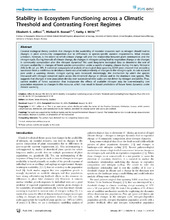Stability in Ecosystem Functioning across a Climatic Threshold and Contrasting Forest Regimes
Peer reviewed, Journal article
Published version
Permanent lenke
https://hdl.handle.net/1956/5274Utgivelsesdato
2011-01-18Metadata
Vis full innførselSamlinger
Originalversjon
https://doi.org/10.1371/journal.pone.0016134Sammendrag
Classical ecological theory predicts that changes in the availability of essential resources such as nitrogen should lead to changes in plant community composition due to differences in species-specific nutrient requirements. What remains unknown, however, is the extent to which climate change will alter the relationship between plant communities and the nitrogen cycle. During intervals of climate change, do changes in nitrogen cycling lead to vegetation change or do changes in community composition alter the nitrogen dynamics? We used long-term ecological data to determine the role of nitrogen availability in changes of forest species composition under a rapidly changing climate during the early Holocene (16k to 8k cal. yrs. BP). A statistical computational analysis of ecological data spanning 8,000 years showed that secondary succession from a coniferous to deciduous forest occurred independently of changes in the nitrogen cycle. As oak replaced pine under a warming climate, nitrogen cycling rates increased. Interestingly, the mechanism by which the species interacted with nitrogen remained stable across this threshold change in climate and in the dominant tree species. This suggests that changes in tree population density over successional time scales are not driven by nitrogen availability. Thus, current models of forest succession that incorporate the effects of available nitrogen may be over-estimating tree population responses to changes in this resource, which may result in biased predictions of future forest dynamics under climate warming.
